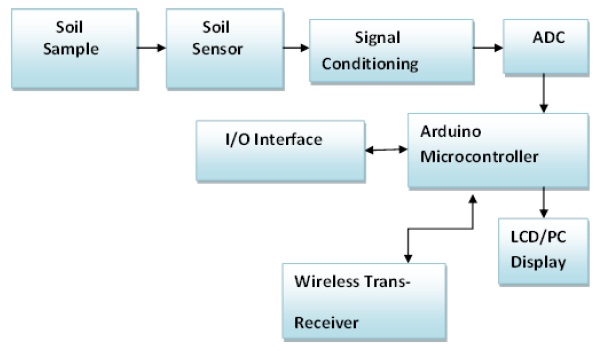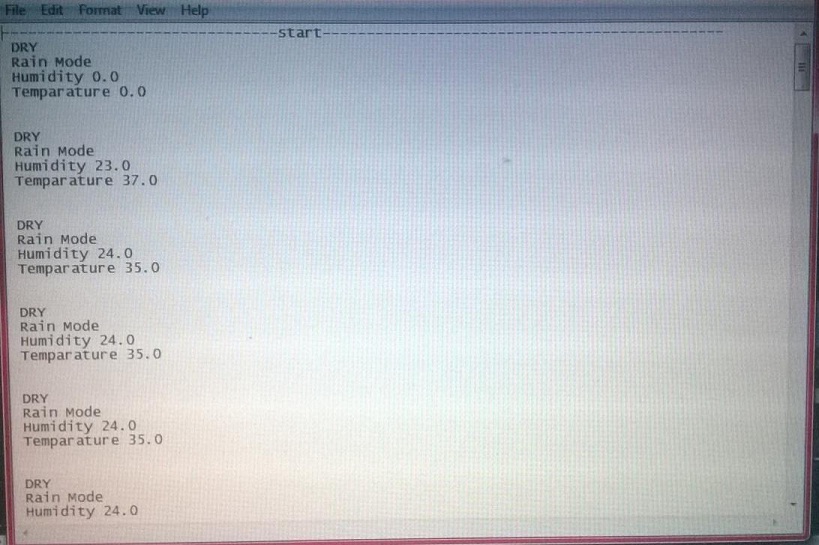





Published on Nov 30, 2023
Monitoring of environmental factors is very important over the last few decades. In particular, monitoring agricultural environments for various factors such as temperature ,moisture, humidity along with other factors can be of more significance. A traditional approach to measure these factors in an agricultural environment meant individuals are taking measurements manually and checking the mat various times. In India, every state around 9 to 10 lakes soil samples have been reviving in laboratories and it is very difficult to test all the soil sample in the stipulated. But soil analysis is the major role for farmers to cultivate and produce to the proper crop. In this paper the soil condition and nutrients level in soil are analyzed by arduino.
Automated soil testing device is an electronic device which can be used to measure moisture, humidity, temperature values to ensure the fertility of soil in the field of agriculture to select the suitable crop and also the type of fertilizer to be used .the ionic particles present in soil sample are sensed by sensor and the output of sensor is processed by signal conditioning circuit. The microcontroller is used to compare the pre-stored value with the actual values and the measured values are displayed on LCD the wireless trans-receiver transmits the data to a remote location or designated authority in the agriculture department for further analysis and suggestions.
Automated soil testing device is a portable device which can be used either in laboratories or on the identified spot selected for farming so that the farmer need not take the pain of visiting the soil testing laborites which are normally located in district headquarters. Automated soil testing device is a simple and user friendly device so that any person can test the soil without the presence of an operator, it is an economical device and thus a common man can easily afford it.
Nowadays, awareness about implementing technology for agricultural environment has increased into the industries. Manual collection of data for desired factors can be sporadic, not continuous and produce variations from incorrect measurement taking. This can cause difficulty in controlling environmental important factors .wireless distinct sensor node scan reduce time and effort required for monitoring the environment.
Nowadays, awareness about implementing technology for agricultural environment has increased into the industries. Manual collection of data for desired factors can be sporadic, not continuous and produce variations from incorrect measurement taking. This can cause difficulty in controlling environmental important factors. Wireless distinct sensor node scan reduce time and effort required for monitoring the environment. The logging of data allows for reduction of data being lost or misplaced. Also it would allow placement in critical locations without the need to put personnel in hazardous situations. Monitoring system scan ensures quicker response times to adverse factor sand conditions, better quality control of the produce and a lower labor cost. the utilization of technology would allow for remote measurement of factors such as temperature, humidity, atmospheric pressure, soil moisture, water level and light detection. Different organizations and researchers find the root causes for decrease in yield and tried to develop the efficient system that will help to increase the production.
• Grouping of soil into classes relative to the nutrient level.
• Predicting the probability of getting profitable response to the fertilizers.
• To provide basis for fertilizers recommendation.
Hardware used: Arduino, LCD, zigbee, sensors
Software used: Arduino IDE, Hyperterminal


The arduino controller operates at40 MHz at 5V D.C. The arduino plays a key role in processing data received from the sensor, where it compares the data already pre-stored with the sensor output signal.
A Liquid Crystal Display is a low cost, low power device capable of displaying text.The LCD controller receives control words from the arduino; it decodes the control word sand performs the corresponding actions on LCD. Once the initialization sequence is done, it displays the soil parameters.
Arduino requires input in digital form, For this Purpose analog to digital converter is used to convert the output of signal conditioning, which is in analog, to digital signal.
Signal conditioning converts output signal from the sensor, which is a weak signal ,,in to a strong signal.
Sensors are hardware devices that produce a measurable response to a change in a physical condition like temperature or pressure. Here copper electrodes are used as sensor which measures the ionic particles present in the soil and converts it in to electrical signal.
Whenever farmer wants to analyze the soil fertility, he leads to take the soil sample of about150 gm and 60 ml of water should be added to the soil sample and allow the sample to settle down the sensor will be placed in the sample. Here copper electrodes are used as sensor which measure the ionic particles present in the soil and converts it into electrical signal. the electrical signal is amplified using signal conditioning and this amplified signal is send to microcontroller in the form of digital signal from ADC the microcontroller place a key role in processing data received from sensor, where it compare the data already pre-stored with the sensor output signal. The microcontroller after comparison gives the output and the values are displayed on the LCD display. The output not only provides the information on fertility present in the soil but also suggest crops to be grown on that soil. The wireless trans-receiver transmits the data to a remote location or designated authority in the agriculture department for further analysis and suggestions.
“Automated Soil Testing in Agriculture”, has been developed for soil testing of agricultural farm. The moisture content, humidity, temperature and pH values vary from one type of soil to others .the parameters of the soil are compared with pre-stored values received from agricultural department .the system also provides the information about the crops that can be grown in respective soils. Wireless communication system has been incorporated for interacting with the experts.

Since the project is a prototype that was developed under some limitations and in short time, there are some tasks that should be done in the future and would develop the system to a more mature state.
The most important and useful job that has to be done is the real field testing for extended time and with several sensor platforms and sensors deployed in fields. This will provide feedback that could be meaningful for the further development of the system and would include the user’s insights and real needs.
Flood control
Water usage audit of house hold, industrial sector and agriculture.
Drying
Weighing and sieving
Best irrigation facility
Soil Testing Device has been developed for soil testing of agricultural farm. The N P K & pH values vary from one type of soil to others. N P K & pH values of soil sample are measured in real-time and compared with the pre-stored values received from the agricultural department. The system also provides the information about the crops that can be grown in respective soils. Wireless communication system has been incorporated for interacting with the experts.
[1] N.ShahandI.Das,“PrecisionIrrigation Sensor Network Based Irrigation”, a book on Problems, Perspectives and Challenges of Agricultural Water Management ,IIT Bombay,India, pp. 217–232, April2008.
[2] Y.Kim, R.Evans and W.Iversen,“Remote Sensing and Control of an Irrigation System Using a Distributed Wireless Sensor Network”,IEEE Transactions onInstrumentationandMeasurement,pp.1379–1387, July2008.
[3] Q.Wang, A.Terzisand A.Szalay ,“A Novel Soi lMeasuring Wireless Sensor Network ”,IEEE Transactions on Instrumentation and Measurement, pp. 412–415,August 2010.
[4] I.Aziz,M.Hasan ,M.Ismail, M.Mehatand N.Haron,“Remote Monitoring in Agricultural Green house using Wireless Sensor and Short Message Service” ,International Journal of Engineering Technology, vol. 9, pp.1–12, September 2010.